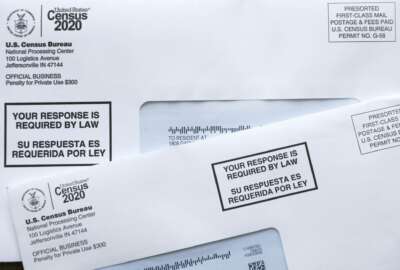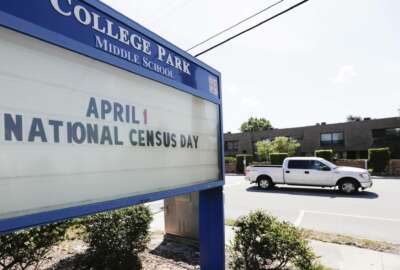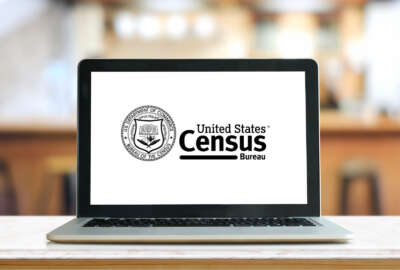
Census Bureau’s new mechanism for processing all of its information
Best listening experience is on Chrome, Firefox or Safari. Subscribe to Federal Drive’s daily audio interviews on Apple Podcasts or PodcastOne. The Census...
Best listening experience is on Chrome, Firefox or Safari. Subscribe to Federal Drive’s daily audio interviews on Apple Podcasts or PodcastOne.
The Census Bureau not only spends a lot of time and effort gathering information, it has a large operation for processing and disseminating it. Recently it retired a long-standing channel, the American FactFinder. For what will replace it and some of the reasoning, the Federal Drive with Tom Temin spoke to the assistant chief of the Center for Enterprise Dissemination, Robert Chestnut.
Interview transcript:
Tom Temin: Mr. Chestnut, good to have you won.
Robert Chestnut: Thank you, Tom. Glad to be here.
Tom Temin: So are people beating down the doors and screaming “Bring back American FactFinder?” Or did the transition go pretty smoothly?
Robert Chestnut: We have a little bit of that right now, but we’ve also had a big communications effort over the last year trying to bring people in and let them know about the new way to access data on www.data.census.gov. And we actually released the application over a year ago so people had a chance to kind of have a nice, gradual transition.
Tom Temin: How would you characterize the people that most used American FactFinder, that most used data.census.gov? I mean, is it mostly academics? Is it mostly marketing people or, tell us?
Robert Chestnut: So we have a very wide variety of data users. American FactFinder supported students, researchers, business owners, other government agencies, the media, nonprofit organizations and many, many others. And the users were coming in. They were looking for data for school projects or maybe a business plan. Grant applications was something people access to the data for a lot. Local community planning and even some disaster recovery planning. So the list of our users and the reason they access the data is extremely long.
Tom Temin: Sure, and describe for us, say the difference in architecture between American FactFinder and what people would encounter there and the new data.census.gov site.
Robert Chestnut: So one of the main focuses is in the shifts with data.census.gov is that it is focused on our census data, what we called application programming interface or the API. The Census Bureau sees the data API as the heart of the enterprise data dissemination platform. This API allows our developers, our – and external developers to easily come in and grab data to include in the applications that their building. At the same time at the Bureau we’re using the data API as our source of data for data.census.gov. So the advantages with that is that when we make an update to the data within the API, it makes every application that uses that data. It updates it right then. A quick example: Maybe some real estate websites will pull in data about your community to show you some key characteristics. They write that code one time, and then we’ll release new data. And the data and that component that they wrote before is updated automatically. So we’re also focusing on a service-based architecture, including some of these services specifically around searching, mapping capabilities and even the table rendering capabilities. The flexibility that this allows us on this architecture is that – easy for us to swap out components and services as the technology changes. For example, say the search technology changes in a few years. We could move to that latest technology without having to redevelop the entire site.
Tom Temin: Well, when you talk about APIs and coding, that sounds like a very different implication than something called FactFinder. And for the casual visitor who wants to find out something about a locale or about a population? Can they still do that without having to program an application to the API?
Robert Chestnut: Yes. So one of the main things still is that we’re trying to reach all of our data users from that very novice user, a student or even someone that wants to update the sign for their town for the 2020 Census with the population of their town, from all of those users to the very advanced researchers to the developers, that is the goal and the focus to be able to meet the needs of that wide variety of users. We still have a single search platform, and that’s actually something that was added versus American FactFinder. There’s a single search bar where you can come in and type in the name of your town or city and actually get a quick profile that gives you data right away and answers a lot of your questions right off the bat.
Tom Temin: And all of this data, now, did you have to rehost it on different systems? I mean, what are some of the IT implications here? Is it all in the cloud now?
Robert Chestnut: So, no. Right now, we’re not all in the cloud. We are still hosting on premises. And the main reasons for this is that we’re still looking at the cost implications of the transactions that we do in the cloud. So with being able to come in and retrieve data and pull it down, and that’s not a model that we have seen work well in the cloud yet, we’re still researching it. We’re trying to find out how we can play in that space. But as of right now, we host everything on premises.
Tom Temin: Basically, the cloud providers don’t charge you to put the data in. They just charge you to take it out, in other words.
Robert Chestnut: Right, and this is a very transactional-based system, cause I’m gonna pull the data based on what you asked for it. So if you come in and ask for something for Washington, D.C., we’re actually gonna go to the database, pull that data out and populate a table specifically for Washington, D.C. at the time of your call.
Tom Temin: We’re speaking with Robert Chestnut. He is the assistant chief of the Center for Enterprise Dissemination at the Census Bureau. And what has the take up been, are you looking at the metrics on usage between the old FactFinder and now the new site?
Robert Chestnut: Yeah, so we have just retired American FactFinder on March 31, like you mentioned earlier, and we’re starting to see an uptick, so we don’t even have a week under our belt. But we have seen kind of a steady increase and the usage. A couple of things that we want to focus on. We want to listen to the feedback that we’re receiving. So we have the ability for people to write in and say if they’re able to find the data and how well that’s going. So we’re really monitoring that closely. But then the other thing that we’re gonna watch is the metrics that people actually accessing the data, how many tables are being accessed, what tables people are accessing, what types of data people are accessing what type of search terms people are using. So we’re starting to watch and monitor all that. But we’ve only had a week where we totally transitioned to data.census.gov.
Tom Temin: Sure, so it’s early. And will you also be looking at the sources of inquiries so that you could say, uh oh, the realtors aren’t looking as much as they used to and maybe you could reach out to different groups?
Robert Chestnut: Yes, with some of the metrics that we can collect that’s one of the key things that we look at. So we know, we definitely conceived throughout the year that whenever we have a big student base and researcher base throughout the fall and the spring and then in the summertime, that kind of slows down with all the .edu access. The government access – we see that throughout the year. And then we can just watch those trends and see who’s accessing the data. And if there’s actually specific groups that we want to reach out to and kind of promote access to, that we have a data that we think would be able to help them in their industry or in their government space, we’re able to kind of tailor that outreach those groups.
Tom Temin: And it looks like the timing of this might have been designed to coincide with the eventual receipt of the national count, the 2020 decennial count. God willing, they’ll be able to get that done in some reasonable fashion, given the situation. But, will that data also be put in behind this new front end?
Robert Chestnut: Yes, so the 2020 Census will be our most exciting release in the next year. So as you know, it’s happening right now and the data will be collected, tabulated and delivered to our group and data.census.gov will have the 2020 data sets starting in early 2021. But this year we have data coming out from the economic census, which was collected in 2017. This provides a great deal of detail on our economy, and our nation’s businesses. This data’s being released out on a flow basis with updates weekly and sometimes even twice a week. Another data set that generates a great deal of interest is the American Community Survey, which is data on a wide range of topics from population, age, race income, health insurance, veterans and many more topics. So this data is released annually starting in September, and then we’re also working to release some of those other 130 data sets or so that the Census Bureau collects that are hidden on census.gov. We’re trying to get some of those data sets into data.census.gov and make them available for users to access there.
Tom Temin: So you’re really at the beginning of a long journey here?
Robert Chestnut: Yeah, very early in the process. We expect more and more data to be released over the next 10 years or so, and that’s what we’re focusing on right now.
Tom Temin: And for those users that might have missed the webinar that you did a couple weeks ago, is that still archived online? That they can still watch it?
Robert Chestnut: Yes, we can provide you with the link for that. And yes, we have been recording all the webinars. We’ve actually had several. As I mentioned earlier we’ve done a lot of outreach over the last year, and we’ve had several of these webinars where we’ve had some great attendance from everyone from reporters to researchers to school and academia. So we have that available that we can put out. And we also have another resource page that actually gives some kind of how-to videos and little bit of tutorial for finding data on data.census.gov.
Tom Temin: Robert Chestnut is assistant chief of the Center for Enterprise Dissemination at the Census Bureau. Thanks so much for joining me.
Robert Chestnut: Thank you Tom, appreciate the chance.
Tom Temin: We’ll post this interview at www.federalnewsnetwork.com/FederalDrive. Hear the Federal Drive on demand and on your device. Subscribe at Apple Podcasts or Podcastone. Stay up to date on your agency’s latest responses to coronavirus. Visit our Special Resource page at www.federalnewsnetwork.com.
Copyright © 2024 Federal News Network. All rights reserved. This website is not intended for users located within the European Economic Area.
Tom Temin is host of the Federal Drive and has been providing insight on federal technology and management issues for more than 30 years.
Follow @tteminWFED





